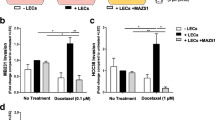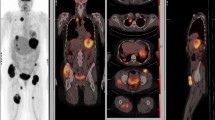Abstract
Breast cancer often spreads from the primary tumor to regional lymph nodes. Lymph node status provides clinically important information for making treatment decisions. Spread via lymphatics is also important for the biology of breast cancer, as tumor cells in lymph nodes may provide a reservoir of cells leading to distant, lethal metastases. Improved understanding of the biology of lymphatic spread thus is important for improved breast cancer survival. Advances towards understanding the interactions between tumors cells and lymphatic vessels have in part been limited by the lack of suitable cell lines and experimental models. We have addressed this need by developing a new model of lymphatic metastasis. Here we describe the establishment of 468LN cells, a variant of the MDA-MB-468 human breast adenocarcinoma cell line, which produces extensive lymph node metastasis following orthotopic injection of nude mice. 468LN cells are also more aggressive in vitro, produce more osteopontin and express different surface integrins compared to the parent line. The dramatic in vitro and in vivo phenotypic and molecular differences of 468LN and parental 468GFP cells make this pair of cell lines a unique model for the specific study of lymph node metastasis of breast cancer.
Similar content being viewed by others
Abbreviations
- ECM:
-
extracellular matrix
- EGFR:
-
epidermal growth factor receptor
- GFP:
-
green fluorescent protein
- mfp:
-
mammary fat pad
- OPN:
-
osteopontin
- VCAM-1:
-
vascular cell adhesion molecule
References
B Fisher M Bauer DL Wickerham et al. (1983) ArticleTitleRelation of number of positive nodes to the prognosis of patients with primary breast cancer. An N.S.A.B.P. update Cancer 52 1551–57 Occurrence Handle6352003
RS Foster SuffixJr (1996) ArticleTitleThe biologic and clinical significance of lym- phatic metastases in breast cancer Surg Oncol Clin N Am 5 79–104 Occurrence Handle8789495
CL Carter C Allen DE Henson (1989) ArticleTitleRelation of tumor size, lymph node status, and survival in 24,740 breast cancer cases Cancer 63 181–87 Occurrence Handle2910416
CJ Ranaboldo A Mitchel GT Royle et al. (1993) ArticleTitleAxillary nodal status in women with screen-detected breast cancer Eur J Surg Oncol 19 130–33 Occurrence Handle8491316
RT Greenlee MB Hill-Harmon T Murray M Thun (2001) ArticleTitleCancer statistics, 2001 CA Cancer J Clin 51 15–36 Occurrence Handle11577478
IJ Fidler (2001) Molecular biology of cancer: invasion and metastasis VT Devita SuffixJr. S Hellman SA Rosenberg (Eds) Cancer, Principles and Practice of Oncology EditionNumber6 Lippincott Williams and Wilkins Philadelphia 135–53
PO Trappen ParticleVan MS Pepper (2002) ArticleTitleLymphatic dissemination of tumor cells and the formation of micrometastases Lancet Oncol 3 44–52 Occurrence Handle10.1016/S1470-2045(01)00621-0 Occurrence Handle11905605
WL McGuire (1987) ArticleTitlePrognostic factors for recurrence and survival in human breast cancer Breast Cancer Res 10 5–9 Occurrence Handle10.1007/BF01806129
T Nemoto J Vana RN Bedwani et al. (1980) ArticleTitleManagement and survival of female breast cancer: results of a national survey by the American College of Surgeons Cancer 45 2917–24 Occurrence Handle7388735
AF Chambers AC Groom IC MacDonald (2002) ArticleTitleDissemination and growth of cancer cells in metastatic sites Nat Rev Cancer 8 563–72 Occurrence Handle10.1038/nrc865
K Pantel RH Brakenhoff (2004) ArticleTitleDissecting the metastatic cascade Nat Rev Cancer. 4 448–56 Occurrence Handle10.1038/nrc1370 Occurrence Handle15170447
LA Liotta WG Stetler-Stevenson (1993) Principles of molecular cell biology of cancer: Cancer metastasis VT Devita SuffixJr S Hellman SA Rosenberg (Eds) Cancer, Principles and Practice of Oncology EditionNumber4 JB Lippincott Philadelphia 134–49
GH Cunnick WG Jiang KF Gomez RE Mansel (2002) ArticleTitleLymphangiogenesis and breast cancer metastasis Histol Histopathol 17 863–70 Occurrence Handle12168797
JW Pickren (1956) ArticleTitleLymph node metastases in carcinoma of the female mammary gland Bull Roswell Park Mem Inst 1 79–85
SA Stacker ME Baldwin MG Achen (2002) ArticleTitleThe role of tumor lym- phangiogenesis in metastatic spread FASEB J 16 922–34 Occurrence Handle10.1096/fj.01-0945rev Occurrence Handle12087053
G Oliver M Detmar (2002) ArticleTitleThe rediscovery of the lymphatic system: old and new insights into the development and biological function of the lymphatic vasculature Genes Dev 16 773–83 Occurrence Handle10.1101/gad.975002 Occurrence Handle11937485
I Carr (2004) ArticleTitleLymphatic metastasis Br J Cancer 90 752–55 Occurrence Handle10.1038/sj.bjc.6601590 Occurrence Handle14970848
JP Sleeman (2000) ArticleTitleThe lymph node as a bridgehead in the metastatic dissemination of tumors Recent Results Cancer Res 157 55–81 Occurrence Handle10857162
MD McCarter JH Clarke AH Harken (2004) ArticleTitleLymphangiogenesis is pivotal to the trials of a successful cancer metastasis Surgery 135 121–24 Occurrence Handle10.1016/S0039-6060(03)00342-8 Occurrence Handle14739845
M Jeltsch T Tammela K Alitalo J Wilting (2003) ArticleTitleGenesis and pathogenesis of lymphatic vessels Cell Tissue Res 314 69–84 Occurrence Handle10.1007/s00441-003-0777-2 Occurrence Handle12942362
JE Price A Polyzos RD Zhang LM Daniels (1990) ArticleTitleTumorigenicity and metastasis of human breast carcinoma cell lines in nude mice Cancer Res 50 717–21 Occurrence Handle2297709
JE Price RD Zhang (1990) ArticleTitleStudies of human breast cancer metastasis using nude mice Cancer Metast Rev 8 285–97 Occurrence Handle10.1007/BF00052605
RD Zhang IJ Fidler JE Price (1991) ArticleTitleRelative malignant potential of human breast carcinoma cell lines established from pleural effusions and a brain metastasis Invasion Metast 11 204–15
DR Welch (1997) ArticleTitleTechnical considerations for studying cancer metastasis in vivo Clin Exp Metast 15 272–306 Occurrence Handle10.1023/A:1018477516367
R Cailleau M Olive QVJ Cruciger (1978) ArticleTitleLong-term human breast carcinoma cell lines of metastatic origin: preliminary characterization In Vitro 14 911–15 Occurrence Handle730202
GN Naumov IC MacDonald PM Weinmeister et al. (2002) ArticleTitlePersistence of solitary mammary carcinoma cells in a secondary site: A possible contributor to dormancy Cancer Res 62 2162–68 Occurrence Handle11929839
SA Vantyghem SM Wilson CO Postenka et al. (2005) ArticleTitleDietary genistein reduces metastasis in a post-surgical orthotopic breast cancer model Cancer Res 65 3396–403 Occurrence Handle15833874
DS Bautista JW Xuan C Hota et al. (1994) ArticleTitleInhibition of Arg–Gly–Asp (RGD)-mediated cell adhesion to osteopontin by a monoclonal antibody against osteopontin J Biol Chem 269 23280–85 Occurrence Handle8083234
AB Tuck DM Arsenault FP O’Malley et al. (1999) ArticleTitleOsteopontin induces increased invasiveness and plasminogen activator expression of human mammary epithelial cells Oncogene 18 4237–46 Occurrence Handle10.1038/sj.onc.1202799 Occurrence Handle10435636
SA Stacker MG Achen L Jussila et al. (2002) ArticleTitleLymphangiogenesis and cancer metastasis Nat Rev Cancer 2 573–83 Occurrence Handle10.1038/nrc863 Occurrence Handle12154350
IJ Fidler (1973) ArticleTitleSelection of successive tumor lines for metastasis Nature 242 148–49
G Poste (1982) ArticleTitleExperimental systems for analysis of the malignant phenotype Cancer Metast Rev 1 141–99 Occurrence Handle10.1007/BF00048224
EA Clark TR Golub ES Lander RO Hynes (2000) ArticleTitleGenomic analysis of metastasis reveals an essential role for RhoC Nature 406 532–35 Occurrence Handle10.1038/35020106 Occurrence Handle10952316
L Weiss (1983) ArticleTitleRandom and nonrandom processes in metastasis, and metastatic inefficiency Invasion Metast 3 193–207
RP Hill AF Chambers V Ling JF Harris (1984) ArticleTitleDynamic heterogeneity: rapid generation of metastatic variants in mouse B16 melanoma cells Science 224 998–1001 Occurrence Handle6719130
JL Yu JW Rak P Carmeliet et al. (2001) ArticleTitleHeterogeneous vascular dependence of tumor cell populations Am J Pathol 158 1325–34 Occurrence Handle11290550
B Boyer AM Valles N Edme (2000) ArticleTitleInduction and regulation of epithelial-mesenchymal transitions Biochem Pharmacol 60 1091–99 Occurrence Handle10.1016/S0006-2952(00)00427-5 Occurrence Handle11007946
P Savagner (2001) ArticleTitleLeaving the neighborhood. Molecular mechanisms involved during epithelial-mesenchymal transition Bioessays 23 912–23 Occurrence Handle10.1002/bies.1132 Occurrence Handle11598958
GL Nicolson (1988) ArticleTitleCancer metastasis: tumor cell and host organ properties important in metastasis to specific secondary sites Biochim Biophys Acta 948 175–224 Occurrence Handle3052592
IJ Fidler (2002) ArticleTitleThe organ microenvironment and cancer metastasis Differentiation 70 498–505 Occurrence Handle10.1046/j.1432-0436.2002.700904.x Occurrence Handle12492492
TJ Yeatman GL Nicolson (1993) ArticleTitleMolecular basis of tumor progression: mechanisms of organ-specific tumor metastasis Semin Surg Oncol 9 256–63 Occurrence Handle8516614
LA Liotta EC Kohn (2001) ArticleTitleThe microenvironment of the tumour-host interface Nature 411 375–79 Occurrence Handle10.1038/35077241 Occurrence Handle11357145
JD Hood DA Cheresh (2002) ArticleTitleRole of integrins in cell invasion and migration Nat Rev Cancer 2 91–100 Occurrence Handle10.1038/nrc727 Occurrence Handle12635172
H Jin J Varner (2004) ArticleTitleIntegrins: Roles in cancer development and as treatment targets Br J Cancer 90 561–65 Occurrence Handle10.1038/sj.bjc.6601576 Occurrence Handle14760364
JL Jones RA Walker (1999) ArticleTitleIntegrins: a role as cell signalling molecules Mol Pathol 52 208–13 Occurrence Handle10694941
MG Coppolino S Dedhar (2000) ArticleTitleBi-directional signal transduction by integrin receptors Int J Biochem Cell Biol, 32 171–88
AB Tuck AF Chambers (2001) ArticleTitleThe role of osteopontin in breast cancer: clinical and experimental studies J Mammary Gland Biol Neoplasia 4 419–29 Occurrence Handle10.1023/A:1014734930781
SR Rittling AF Chambers (2004) ArticleTitleRole of osteopontin in tumour progression Br J Cancer 90 1877–81 Occurrence Handle10.1038/sj.bjc.6601839 Occurrence Handle15138464
DV Denhardt X Guo (1993) ArticleTitleOsteopontin. A protein with diverse functions FASEB J 7 1475–82 Occurrence Handle8262332
A Bellahcene V Castronovo (1995) ArticleTitleIncreased expression of osteonectin and osteopontin, two bone matrix proteins, in human breast cancer Am J Pathol 146 95–100 Occurrence Handle7856741
A O’Regan JS Berman (2000) ArticleTitleOsteopontin: A key cytokine in cell-mediated and granulomatous inflammation Int J Exp Pathol 81 373–90 Occurrence Handle10.1046/j.1365-2613.2000.00163.x Occurrence Handle11298186
AB Tuck BE Elliott C Hota et al. (2000) ArticleTitleOsteopontin-induced, integrin-dependent migration of human mammary epithelial cells involves activation of the hepatocyte growth factor receptor (Met) J Cell Biochem 78 465–75 Occurrence Handle10.1002/1097-4644(20000901)78:3<465::AID-JCB11>3.0.CO;2-C Occurrence Handle10861844
KA Furger AL Allan SM Wilson et al. (2003) ArticleTitleBeta(3) integrin expression increases breast carcinoma cell responsiveness to the malignancy-enhancing effects of osteopontin Mol Cancer Res 1 810–19 Occurrence Handle14517343
LL Smith HK Cheung LE Ling et al. (1996) ArticleTitleOsteopontin N-terminal domain contacts a cryptic adhesive sequence recognized by α9β1 integrin J Biol Chem 271 28485–91 Occurrence Handle10.1074/jbc.271.45.28485 Occurrence Handle8910476
Y Yokosaki N Matsuura T Sasaki et al. (1999) ArticleTitleThe integrin α9β1 binds to a novel recognition sequence (SVVYGLR) in the thrombin-cleaved amino-terminal fragment of osteopontin J Biol Chem 274 36328–34 Occurrence Handle10.1074/jbc.274.51.36328 Occurrence Handle10593924
Y Yokosaki EL Palmer AL Prieto et al. (1994) ArticleTitleThe integrin α9β1 mediates cell attachment to a non-RGD site in the third fibronectin type III repeat of tenascin J Biol Chem 269 26691–96 Occurrence Handle7523411
Y Taooka J Chen T Yednock D Sheppard et al. (1999) ArticleTitleThe integrin α9β1 mediates adhesion to activated endothelial cells and transendothelial neutrophil migration through interaction with vascular cell adhesion molecule-1 J Cell Biol 145 413–20 Occurrence Handle10.1083/jcb.145.2.413 Occurrence Handle10209034
NE Vlahakis BA Young A Atakilit D Sheppard (2005) ArticleTitleThe lymphangiogenic vascular endothelial growth factors VEGF-C and -D are ligands for the integrin α9β1 J Biol Chem 280 4544–52 Occurrence Handle10.1074/jbc.M412816200 Occurrence Handle15590642
Author information
Authors and Affiliations
Corresponding author
Rights and permissions
About this article
Cite this article
Vantyghem, S.A., Allan, A.L., Postenka, C.O. et al. A New Model for Lymphatic Metastasis: Development of a Variant of the MDA-MB-468 Human Breast Cancer Cell Line that Aggressively Metastasizes to Lymph Nodes. Clin Exp Metastasis 22, 351–361 (2005). https://doi.org/10.1007/s10585-005-0745-1
Received:
Accepted:
Issue Date:
DOI: https://doi.org/10.1007/s10585-005-0745-1




